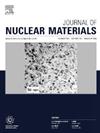1200°C 下厚铬涂层的微观结构演变和高温空气氧化行为
IF 2.8
2区 工程技术
Q3 MATERIALS SCIENCE, MULTIDISCIPLINARY
引用次数: 0
摘要
通过磁控溅射沉积制备了厚铬涂层 Zr-4 合金,并研究了其微观结构演变和高温空气氧化行为。氧化试验表明,即使在某些区域形成了α-Zr(O)层,厚铬涂层也能提高 Zr-4 合金的高温空气抗氧化性。此外,还详细讨论了高温空气氧化的机理,这些实验结果可为建立可靠的降解预测模型提供数据。本文章由计算机程序翻译,如有差异,请以英文原文为准。
Microstructure evolution and high temperature air oxidation behaviour of thick Cr coatings at 1200°C
The thick Cr coated Zr-4 alloys were prepared by magnetron sputtering deposition and their microstructure evolution and high-temperature air oxidation behaviour were investigated. Oxidation tests showed that the thick Cr coatings can improve the high-temperature air oxidation resistance of Zr-4 alloy even if the α-Zr(O) layer was formed at some regions. The mechanism of high-temperature air oxidation was also discussed in detail, and these experimental results could provide data for establishing a reliable prediction model of this degradation.
求助全文
通过发布文献求助,成功后即可免费获取论文全文。
去求助
来源期刊

Journal of Nuclear Materials
工程技术-材料科学:综合
CiteScore
5.70
自引率
25.80%
发文量
601
审稿时长
63 days
期刊介绍:
The Journal of Nuclear Materials publishes high quality papers in materials research for nuclear applications, primarily fission reactors, fusion reactors, and similar environments including radiation areas of charged particle accelerators. Both original research and critical review papers covering experimental, theoretical, and computational aspects of either fundamental or applied nature are welcome.
The breadth of the field is such that a wide range of processes and properties in the field of materials science and engineering is of interest to the readership, spanning atom-scale processes, microstructures, thermodynamics, mechanical properties, physical properties, and corrosion, for example.
Topics covered by JNM
Fission reactor materials, including fuels, cladding, core structures, pressure vessels, coolant interactions with materials, moderator and control components, fission product behavior.
Materials aspects of the entire fuel cycle.
Materials aspects of the actinides and their compounds.
Performance of nuclear waste materials; materials aspects of the immobilization of wastes.
Fusion reactor materials, including first walls, blankets, insulators and magnets.
Neutron and charged particle radiation effects in materials, including defects, transmutations, microstructures, phase changes and macroscopic properties.
Interaction of plasmas, ion beams, electron beams and electromagnetic radiation with materials relevant to nuclear systems.
 求助内容:
求助内容: 应助结果提醒方式:
应助结果提醒方式:


